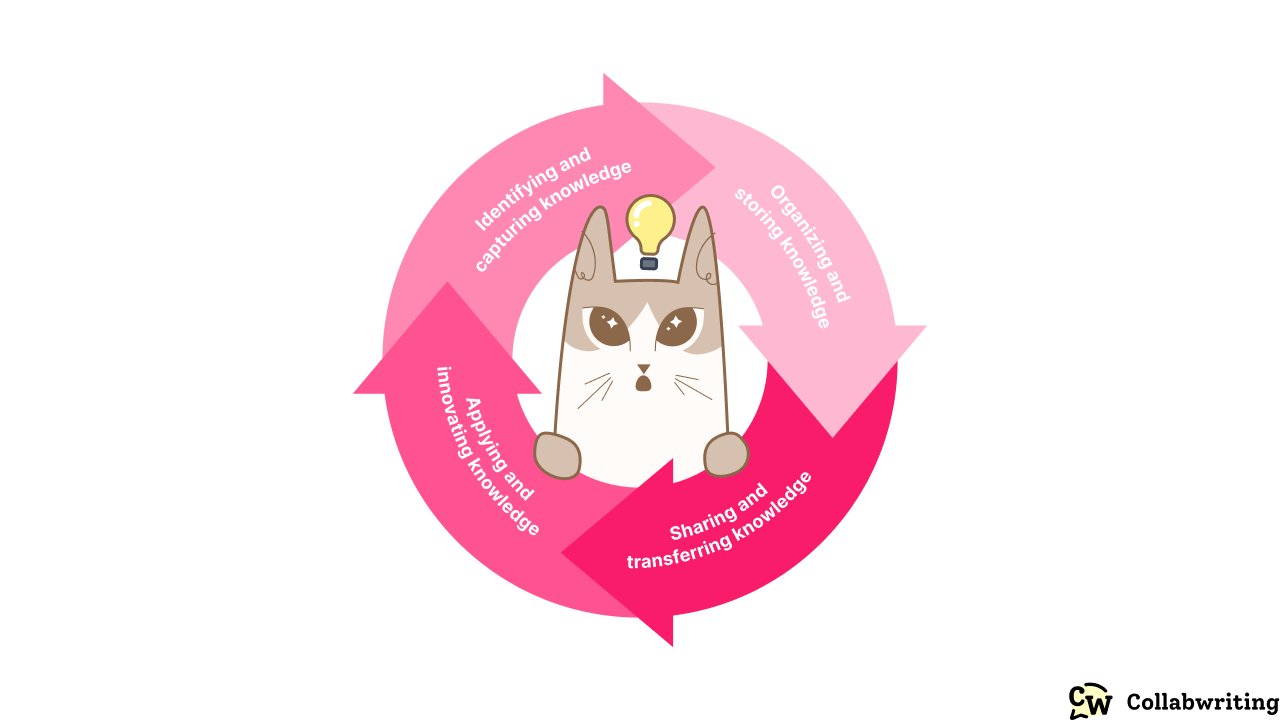Keeping all the important knowledge inside the company can be tricky. Sorting it out, figuring it out, and sharing it can be a puzzle because there's always a ton of new stuff pouring in every day.
To prevent teams and people in the company from getting confused, and to make the knowledge management process easier for them, there's something called the knowledge management cycle.
With just 4 steps, this cycle turns the process into a smooth journey from learning to improving the company.
These steps involve:
- Identifying and capturing knowledge
- Organizing and storing knowledge
- Sharing and transferring knowledge
- Applying and innovating knowledge
What is the meaning of knowledge?
Knowledge refers to information, understanding, or skills acquired through experience, education, or training. It involves awareness
and familiarity with facts, truths, concepts, or skills that are
acquired and retained by an individual.
If we dig deeper, we can categorize knowledge into three types:
- Explicit knowledge: This is information you can write down and share. It's the kind of knowledge that's easy for employees to access and pass along. For instance, it could be details about a product in a case study.
- Implicit knowledge: This is what you learn through experience. So, if explicit knowledge is the info in a case study, implicit knowledge is what you get when you actually use that info. Like applying it in a meeting with a client.
- Tacit knowledge: This is trickier to put into words and share formally. Think of it as the unspoken rules in a workplace, like how employees are expected to interact with clients, such as dressing a certain way.
The knowledge management cycle
The process of creating a culture that values knowledge sharing can be pretty simple if you follow the 4 main steps.
Step 1: Identifying and capturing knowledge
The first step in the knowledge management cycle involves collecting insights and expertise from various sources. Techniques like knowledge mapping, expert interviews, and document analysis help with this.
Organizations can use knowledge mapping to visualize what they know. It's like creating a picture of all the different types of knowledge they have, including written stuff like documents and reports, and hands-on knowledge like expertise and experience. This helps them spot gaps and where knowledge is super concentrated, so they can focus on capturing the most important stuff.
Talking to experts is another smart way to capture knowledge. Whether it's one-on-one chats, group sessions, or virtual meetings, getting insights from people who know their stuff is gold.
And don't forget about existing documents: reports, manuals, research papers. By digging into them systematically, organizations uncover insights and best practices that might be buried in the text.
Once they find all this great knowledge, it's time to capture and document it in an organized way. This happens in knowledge repositories - like databases or wikis. These become central hubs where everyone in the organization can easily find and share knowledge.
Usually, these repositories can handle different types of knowledge - documents, videos, presentations, and even audio recordings. They come with handy features like search tools and collaboration options, making it easy for everyone to use and contribute to the knowledge stored there.
Step 2: Organizing and storing knowledge
Making sure knowledge is organized and stored well is super important for smooth knowledge management. This means putting knowledge into categories and using tags to make it easy to find.
And here's the cool part: setting up a good search system in the knowledge hub. This way, employees can find what they need super quickly. When knowledge is structured logically, it makes it easier for everyone to share and work together.
Step 3: Sharing knowledge
Sharing and passing on knowledge is the core of the knowledge management cycle. This step is about making a culture where everyone in the organization shares what they know and works together. Ways to do this include team meetings, training sessions, and using platforms where people can collaborate.
When there's open communication and everyone works together, the organization taps into its collective smarts, leading to more cool ideas and better problem-solving.
Step 4: Applying and innovating with knowledge
The final step of the knowledge management cycle is all about using and coming up with new ideas with what you know.
This means taking the knowledge you've gathered to solve problems, make smart choices, and bring in new stuff in the organization. When everyone in the team pitches in with their smarts, the organization gets even better and can handle changes in the market.
And here's the smart move: keep the learning going. Make a loop where you learn from what you've done before. This way, the organization keeps getting better by staying updated and relevant.

Benefits of implementing a knowledge management cycle
Putting a knowledge management cycle into action brings many good things to organizations. It helps them make smart choices, avoid doing the same thing over and over, and make the workplace a learning-friendly spot. When everyone can easily get and use the knowledge they need, the whole team works better and gets things done faster.
A well-done knowledge management cycle makes the organization super creative and open to new ideas. It encourages teamwork and exploring new stuff. It's like finding the best ways to do things and learning from what works, so the organization keeps getting better and can handle changes in its industry.
Learn more: 3 key benefits of sharing knowledge with team members (with examples)
Overcoming challenges in the knowledge management cycle
While the knowledge management cycle offers significant benefits, it also comes with its own set of challenges.
One common challenge is the resistance to change and the reluctance to share knowledge among employees. Overcoming this challenge requires effective change management strategies and creating a supportive environment that values knowledge sharing and collaboration.
Another challenge lies in the maintenance and updating of knowledge repositories. Without regular updates, knowledge can quickly become outdated, leading to inaccurate information and reduced effectiveness. Implementing regular review processes and assigning ownership of knowledge repositories can help address this challenge.

Best practices for successful knowledge management
Achieving successful knowledge management involves a few key steps.
First, organizations need to set clear goals and create a strategy in line with their business objectives. This means figuring out what knowledge is crucial and setting up ways to capture, store, and share it.
Next, it's essential to build a culture where everyone is eager to share what they know. Encouraging contributions with incentives, recognition, and good communication is key. Plus, offering training and support helps everyone get better at managing knowledge.
Lastly, organizations should keep an eye on how well their knowledge management is working. This includes checking things like how often knowledge is being used, how engaged employees are in sharing, and how it impacts overall performance.
Regularly assessing and tweaking these processes helps organizations keep getting better and get the most value from their knowledge.

Conclusion
Implementing a knowledge management cycle is like creating a roadmap for organizations to navigate the challenges of information overload.
By identifying, organizing, sharing, and applying knowledge effectively, teams can work cohesively, make informed decisions, and foster innovation. This simple and structured approach not only improves organizational efficiency but also creates a culture that values continuous learning and adaptation.
With the right practices in place, organizations can overcome challenges, enjoy the benefits of collective wisdom, and stay resilient in the face of change.
Get started by checking out Collabwriting and become a champion of knowledge sharing.

Collabwriting - Shareable Notes on Web Pages and PDFs
Collabwriting turns a messy browser into seamless team collaboration. Collect snippets of information from anywhere online (even books and videos), attach your own insights, and create a dynamic knowledge system for your team.
FAQ
What is the knowledge management cycle?
The knowledge management cycle is a systematic approach to handling the creation, organization, sharing, and application of knowledge within an organization. It involves 4 main steps: identifying and capturing knowledge, organizing and storing knowledge, sharing and transferring knowledge, and applying and innovating with knowledge.
Why is the knowledge management cycle important?
The knowledge management cycle is important because it helps organizations manage their knowledge effectively, reducing confusion and improving efficiency. It ensures that valuable information is captured, organized, and easily accessible, leading to better decision-making, innovation, and continuous improvement.
What are the three types of knowledge?
- Explicit Knowledge: Information that can be easily written down and shared, such as details in a case study.
- Implicit Knowledge: Skills and understanding gained through experience, like applying information from a case study in a real-world situation.
- Tacit Knowledge: Knowledge that is difficult to articulate and share formally, such as unspoken workplace norms and expectations.
How can an organization capture knowledge?
Organizations can capture knowledge through methods like knowledge mapping to visualize existing knowledge, expert interviews to gather insights, and document analysis to extract information from existing materials. This knowledge is then documented and stored in organized knowledge repositories.
What are the benefits of implementing a knowledge management cycle?
Benefits include improved decision-making, increased efficiency by reducing repetitive work, fostering a culture of continuous learning and innovation, and enhancing organizational creativity and adaptability. It also helps in creating a cohesive team environment where knowledge is easily accessible and shared.
What are some best practices for successful knowledge management?
Best practices include setting clear goals and aligning the knowledge management strategy with business objectives, building a culture that encourages knowledge sharing through incentives and recognition, providing training and support for effective knowledge management, and regularly assessing and improving knowledge management processes.
How can technology help in the knowledge management cycle?
Technology can help by providing tools for creating, organizing, and accessing knowledge repositories, facilitating communication and collaboration among employees, and offering platforms that support real-time information sharing and problem-solving.
What tool can help in documenting and sharing knowledge within the team?
Tools like Collabwriting can assist in capturing and sharing knowledge within the team, making the process more efficient and ensuring that important information is easily accessible to everyone.






![Best Research Collaboration Tools in 2025: Zotero, Paperpile & Collabwriting [Compared]](/content/images/2025/07/image--7--1.png)








